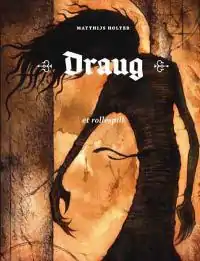 Cover of the Draug rulebook | |
| Designers | Matthijs Holter |
|---|---|
| Publishers | Spartacus |
| Publication | 2004 |
| Genres | Historical, Fantasy |
| Systems | FUDGE |
Draug is a Norwegian supernatural horror role-playing game (RPG) published by Spartacus Forlag in 2004.
Contents
Draug (named after a type of fictional Scandinavian undead), is set in a semi-historically accurate Norway of 1801 that features supernatural creatures from Norwegian fairy tales. The game, which uses the FUDGE game system,[1] is designed for 1–5 players and a gamemaster.
The players create characters who have ten traits or abilities (two of them great, three of them good, and five of them only fair).[2] The characters are ordinary people who are plagued by supernatural creatures such as nøkken, hulder, vetter, trolls, and nisser. The game focuses on cooperative problem-solving rather than combat.[3]
Publication history
Draug was created by Matthijs Holter in 2004 and was published by Spartacus Forlag[3] as a 240-page book that is divided into information for players, information for the gamemaster, and several adventures. It was the first RPG to be based on Norwegian history and beliefs.[4]
The following year, Holter followed up with the first supplement, Beist og Borgerskap ("Beast and Bourgoisie"), a 73-page book of three adventures with three different modes of play:
- "Festligheter på Fladebye" ("Festival at Fladebye") is a murder mystery set in high society.
- "Uren, Luren" ("Up in the Hills") is a narrativisic adventure inspired by Norwegian folk tales collected by Asbjørnsen and Moe.
- "Jern Katja" ("Iron Katja") is a horror adventure set in a rural environment with a tragedy in its past.[5]
Reception
In a review for the Norwegian magazine VG, Brynjulf Jung Tjønn liked the game, saying, "With the help of some dice and a book of 240 pages, you can make Norway a free country in the 19th century."[4]
In a review for the Norwegian magazine Universitas, Vegard Den Lokale Uteliggeren complimented the game on its simplicity, saying, "The rules are simple and easy to understand, and you apparently do not need a calculator or nerd skills to play." Uteliggeren did caution that "It is possible that it will only become really interesting if you are interested in history and folklore." Uteliggeren also thought that the game occasionally veered too close to mundane, noting that "Some of the environmental descriptions in Draug are dangerously reminiscent of what one finds in an average school book, but the game is saved by the captivating thought of having to play through Norwegian history where in a dramatic moment the national assembly at Eidsvoll rescues an evil Danish Santa with poisoned porridge." Uteliggeren concluded with a strong recommendation, saying, "[The game] requires a little more advance work, and it can be a little stressful at first to pretend to be a crowded outcast or a hard-working Haugian widow, but in the right surroundings - for example cabin trips in the Norwegian mountains - it should quickly become fun. Anyone who can think of a creative alternative to Ludo or Monopoly should try Draug.""[6]
Writing for the Norwegian magazine Adresseavisen, Tone Almhjell said, "This is brilliant entertainment. (…) There is so much inspiration here that should last for years of fun."[7]
Other reviews
- RPG Review June 2011 (Issue 12)
References
- ↑ Hjorthaug, Svein Børge (2004-08-27). "Review of Draug". RPGnet. Retrieved 2008-01-19.
- ↑ "Draug". Retrieved 2020-09-02.
- 1 2 Mar, Thorsteinn (2018-01-08). "Nordic Role-playing Games". The Yawning Portal. Retrieved 2020-09-02.
- 1 2 Tjønn, Brynjulf Jung (2004-07-19). "Spillet som forandrer Norges historie". VG (in Norwegian). Tromsø/Oslo. Retrieved 2020-09-02.
- ↑ "Draug". BoardGameGeek. Retrieved 2020-09-02.
- ↑ Uteliggeren, Vegard Den Lokale (2004-09-14). "Terninger og troll". Universitas (in Norwegian). Retrieved 2020-09-02.
- ↑ Almhjell, Tone. "Draug". Adresseavisen (in Norwegian).